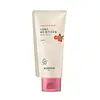What's inside
What's inside
 Key Ingredients
Key Ingredients

No key ingredients
 Benefits
Benefits

 Concerns
Concerns

No concerns
 Ingredients Side-by-side
Ingredients Side-by-side

Water
Skin ConditioningDibutyl Adipate
EmollientPropanediol
SolventDiethylamino Hydroxybenzoyl Hexyl Benzoate
UV FilterTitanium Dioxide
Cosmetic ColorantEthylhexyl Triazone
UV AbsorberPolyglyceryl-3 Distearate
EmulsifyingNiacinamide
SmoothingCaprylyl Methicone
Skin ConditioningCaprylic/Capric Triglyceride
MaskingDicaprylyl Ether
Emollient1,2-Hexanediol
Skin ConditioningDiethylhexyl Butamido Triazone
UV AbsorberPentylene Glycol
Skin ConditioningGlycerin
HumectantVaccinium Macrocarpon Fruit Extract
AstringentPolymethylsilsesquioxane
Morus Nigra Fruit Extract
Skin ConditioningLycium Chinense Fruit Extract
AntioxidantBerberis Vulgaris Root Extract
AntimicrobialFragaria Chiloensis Fruit Extract
Skin ConditioningOlea Europaea Fruit Oil
MaskingAbies Sibirica Oil
MaskingRosmarinus Officinalis Leaf Oil
MaskingSalvia Sclarea Oil
MaskingAnthemis Nobilis Flower Oil
MaskingJuniperus Mexicana Oil
MaskingChamomilla Recutita Flower Oil
MaskingGlyceryl Stearate
EmollientBehenyl Alcohol
EmollientPoly C10-30 Alkyl Acrylate
Emulsion StabilisingMicrocrystalline Cellulose
AbsorbentPolyhydroxystearic Acid
EmulsifyingAmmonium Polyacryloyldimethyl Taurate
Emulsion StabilisingAlumina
AbrasiveStearic Acid
CleansingCellulose Gum
Emulsion StabilisingGlyceryl Stearate Citrate
EmollientAmmonium Acryloyldimethyltaurate/Vp Copolymer
Ethylhexylglycerin
Skin ConditioningXanthan Gum
EmulsifyingAdenosine
Skin ConditioningT-Butyl Alcohol
PerfumingButylene Glycol
HumectantWater, Dibutyl Adipate, Propanediol, Diethylamino Hydroxybenzoyl Hexyl Benzoate, Titanium Dioxide, Ethylhexyl Triazone, Polyglyceryl-3 Distearate, Niacinamide, Caprylyl Methicone, Caprylic/Capric Triglyceride, Dicaprylyl Ether, 1,2-Hexanediol, Diethylhexyl Butamido Triazone, Pentylene Glycol, Glycerin, Vaccinium Macrocarpon Fruit Extract, Polymethylsilsesquioxane, Morus Nigra Fruit Extract, Lycium Chinense Fruit Extract, Berberis Vulgaris Root Extract, Fragaria Chiloensis Fruit Extract, Olea Europaea Fruit Oil, Abies Sibirica Oil, Rosmarinus Officinalis Leaf Oil, Salvia Sclarea Oil, Anthemis Nobilis Flower Oil, Juniperus Mexicana Oil, Chamomilla Recutita Flower Oil, Glyceryl Stearate, Behenyl Alcohol, Poly C10-30 Alkyl Acrylate, Microcrystalline Cellulose, Polyhydroxystearic Acid, Ammonium Polyacryloyldimethyl Taurate, Alumina, Stearic Acid, Cellulose Gum, Glyceryl Stearate Citrate, Ammonium Acryloyldimethyltaurate/Vp Copolymer, Ethylhexylglycerin, Xanthan Gum, Adenosine, T-Butyl Alcohol, Butylene Glycol
 Reviews
Reviews

Ingredients Explained
These ingredients are found in both products.
Ingredients higher up in an ingredient list are typically present in a larger amount.
1,2-Hexanediol is a synthetic liquid and another multi-functional powerhouse.
It is a:
- Humectant, drawing moisture into the skin
- Emollient, helping to soften skin
- Solvent, dispersing and stabilizing formulas
- Preservative booster, enhancing the antimicrobial activity of other preservatives
Butylene Glycol (or BG) is used within cosmetic products for a few different reasons:
Overall, Butylene Glycol is a safe and well-rounded ingredient that works well with other ingredients.
Though this ingredient works well with most skin types, some people with sensitive skin may experience a reaction such as allergic rashes, closed comedones, or itchiness.
Learn more about Butylene GlycolCellulose Gum is a water-soluble polymer that comes from cellulose. It is used to change the texture of a product and to help stabilize emulsions.
As an emulsifier, cellulose gum specifically thicken the texture of water-based products.
This ingredient is considered hypoallergenic and non-toxic. Cellulose Gum can be found in cosmetics, food, and other household goods such as paper products.
Learn more about Cellulose GumEthylhexylglycerin (we can't pronounce this either) is commonly used as a preservative and skin softener. It is derived from glyceryl.
You might see Ethylhexylglycerin often paired with other preservatives such as phenoxyethanol. Ethylhexylglycerin has been found to increase the effectiveness of these other preservatives.
Glycerin is already naturally found in your skin. It helps moisturize and protect your skin.
A study from 2016 found glycerin to be more effective as a humectant than AHAs and hyaluronic acid.
As a humectant, it helps the skin stay hydrated by pulling moisture to your skin. The low molecular weight of glycerin allows it to pull moisture into the deeper layers of your skin.
Hydrated skin improves your skin barrier; Your skin barrier helps protect against irritants and bacteria.
Glycerin has also been found to have antimicrobial and antiviral properties. Due to these properties, glycerin is often used in wound and burn treatments.
In cosmetics, glycerin is usually derived from plants such as soybean or palm. However, it can also be sourced from animals, such as tallow or animal fat.
This ingredient is organic, colorless, odorless, and non-toxic.
Glycerin is the name for this ingredient in American English. British English uses Glycerol/Glycerine.
Learn more about GlycerinWater. It's the most common cosmetic ingredient of all. You'll usually see it at the top of ingredient lists, meaning that it makes up the largest part of the product.
So why is it so popular? Water most often acts as a solvent - this means that it helps dissolve other ingredients into the formulation.
You'll also recognize water as that liquid we all need to stay alive. If you see this, drink a glass of water. Stay hydrated!
Learn more about Water